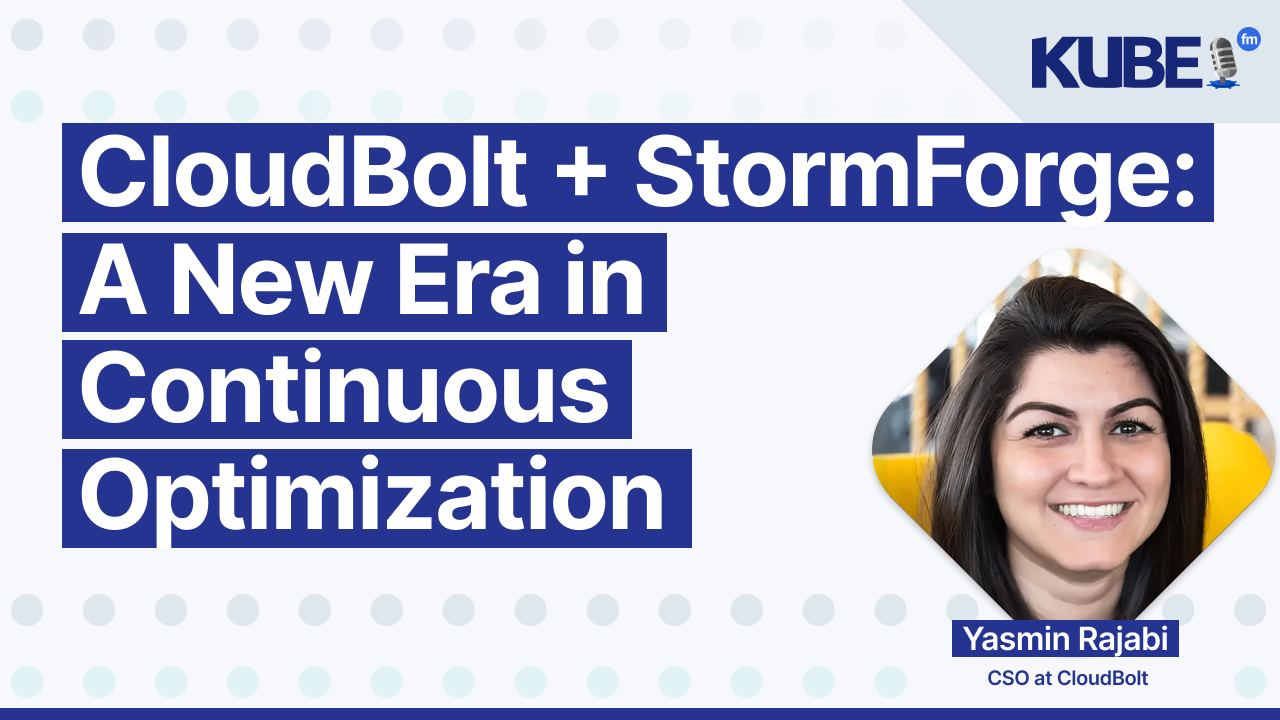CloudBolt + StormForge: A New Era in Continuous Optimization
Apr 28, 2025
CloudBolt has acquired StormForge, combining FinOps leadership with Kubernetes optimization technology.
The acquisition introduces new capabilities including node-level waste reduction and Java workload optimization which uses machine learning to set appropriate heap sizes alongside memory requests and limits.
Their approach differentiates from competitors by working with open-source tools like Karpenter, HPA, and KEDA rather than replacing them with proprietary alternatives.
StormForge's machine learning approach to workload profiling helps determine optimal node placement, addressing the common problem where most organizations use DIY resource tuning or no request/limit management.
Relevant links
Transcription
Bart: So, who are you? What's your role? And who do you work for?
Note: No specific hyperlinks were added because the transcript is a generic question without technical terms or specific references that match the provided links.
Yasmin: My name is Yasmin. I'm currently the Chief Strategy Officer at CloudBolt, and I previously served as head of product at StormForge, which was recently acquired.
Bart: I noticed that the transcript snippet is very short and doesn't contain much context. Could you provide more of the transcript or clarify what specific information Yasmin Rajabi wants to share today? Without more context, I cannot confidently apply hyperlinks.
Yasmin: We have two exciting announcements at KubeCon. We got acquired by CloudBolt, a leader in FinOps and cost optimization. We also had some great product announcements yesterday. Retrospectively, launching product announcements on April Fool's Day is funny, but we have some new node optimization capabilities to reduce waste at the node level. We have made our Java optimization feature generally available (GA). Lastly, we launched our pay-as-you-go support on the AWS marketplace.
Bart: And these features that you just mentioned, what problems are they solving?
Yasmin: Starting from the node level, we typically optimize pods. A common question is, "My nodes have a lot of waste. What can I do?" We always recommend starting with Karpenter. One capability we've added to our software is using machine learning to look at workload profiles. After right-sizing them, we examine the shape of those workloads and determine what nodes they would be best suited on. We then set node affinities to nudge the scheduler to put workloads on the right nodes. The challenge we help solve is reducing waste at the node level.
For Java workloads, when we discuss right-sizing and adjusting requests and limits, users often feel uncomfortable, especially regarding memory and Java heap management. Most recently, we started collecting additional metrics like heap garbage collection from Java workloads. Our machine learning consumes that data and generates recommendations for heap alongside memory requests and limits. This helps users safely optimize waste for Java workloads.
Lastly, our Pay-as-You-Go capability on the AWS Marketplace allows people to get started and pay for what they're using, with no long-term commitment. Users can try the software at a smaller scale without needing to contact a CloudBolt representative.
Bart: Are these features open source? Are they part of the CNCF landscape?
Yasmin: Our software is not open source. It's proprietary because most of our value add is a combination of our machine learning, which is patent pending, and the automation we built around that. However, we built the software to work with all the open source tools in the Kubernetes landscape. For example, we work really well with the HPA, with KEDA, with Karpenter. As we build the software, we try to follow Kubernetes best practices so that we can work alongside all the standards and other tools like Argo that come up often. We just want to make sure we work with all the open source tools out there.
Bart: So, can you tell me a little bit more about StormForge's business model, now that it's part of CloudBolt?
Yasmin: We charge by the vCPU that we optimize. As you reduce your vCPU count, you also spend less on the software, and you only spend more as your application grows. We grow with you. If you are purchasing the software directly, we charge a dollar amount per vCPU. If you're on the AWS marketplace, we bill monthly, calculating by vCPU per hour.
Bart: So who are your main competitors?
Yasmin: The most common scenario we encounter is no tool. Usually, people have either tried a DIY approach to tune their resources or aren't doing anything automatic around setting requests and limits for CPU and memory. Of course, we do come across other competitors like CAST, who are on the show floor today. They take a different approach, offering node optimization and pod optimization with proprietary replacement tools. In contrast, we partner with Karpenter for node optimization, which is open source, and layer on top of other open source tools like the Horizontal Pod Autoscaler (HPA) for pod optimization. Different approaches to the problem, but CAST is a competitor we sometimes see.
Bart: What differentiates the features you're releasing from StormForge, now part of CloudBolt, from the competitors?
Yasmin: From a Java perspective, we're the only pod right-sizing tool that looks at additional Java metrics and uses those to come up with recommendations and actually sets the heap for you. From the node waste level, we take a different approach. While other tools suggest node sizes and right-sizing approaches, we look at what's the best shape for workloads to run based on their profile. It's more of a machine learning-based approach. The pay-as-you-go feature is perhaps less of a differentiator and more focused on customer ease of use to help them get started.

